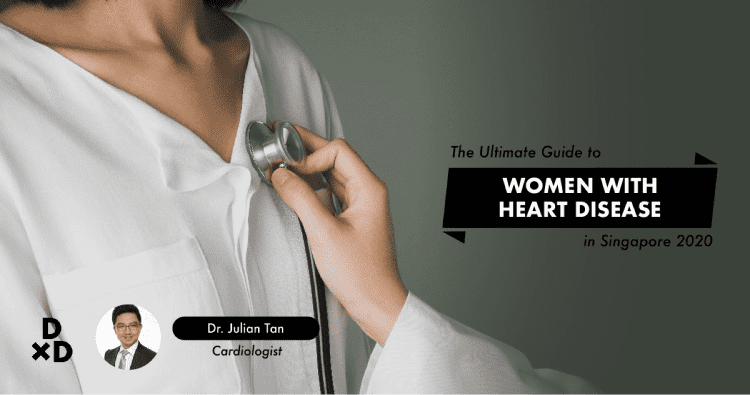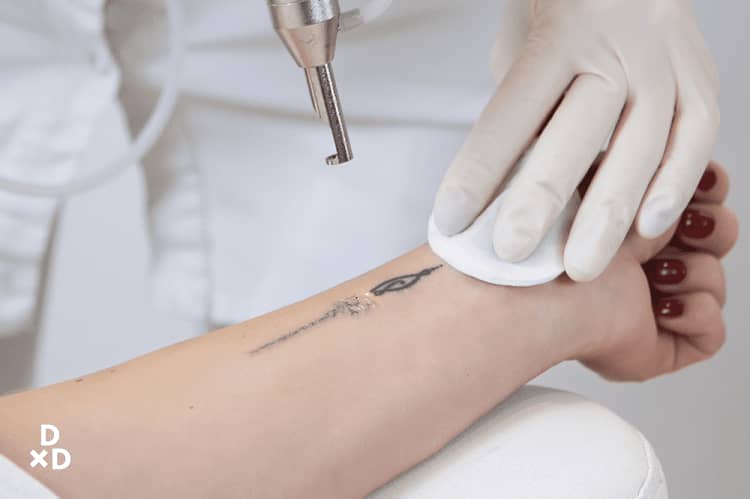It does not matter where, when, or who. Emergencies can happen anywhere and at any time. It may also happen to anyone, regardless of age and condition.
It is always best to be prepared. How you react to an emergency could be a matter of life and death.
If someone's heart stopped beating and they have to wait for an ambulance to arrive, chances are, it is already too late. Permanent brain damage can occur only after 4 minutes without oxygen. Death can also occur within 4-6 minutes [1].
This is why learning First Aid and Basic Life Support is super important. Being trained would give you the skills to assist and provide care for emergency patients before an ambulance arrives.
Anyone can become a certified First Aider. In Singapore, you can find various basic First Aid courses as well as occupational and more advanced courses. Some schools, community centres and offices also provide free basic training.
You might know that it is a very important skill to have. However, what does First Aid actually mean? What are the things that you should know? Read on to find out more!
What is First Aid?
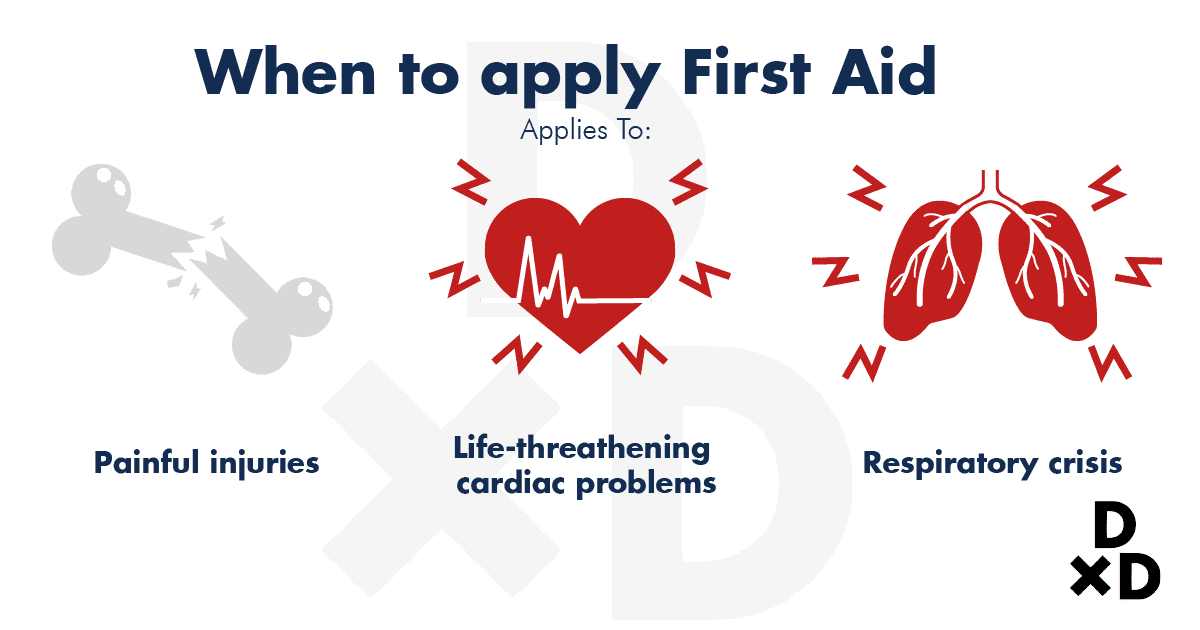
It is a set of simple measures to provide immediate care in cases of: [2]
- Painful injuries
- Life-threatening cardiac problems
- Respiratory crisis
First aid training is meant to be simple and doable by everyone. The training will teach you how to provide support for various common injuries.
This article is by no means an alternative to official training. If you are interested in learning more about first aid, you should search online for the different workshops available!
There are 5 general aims of First Aid
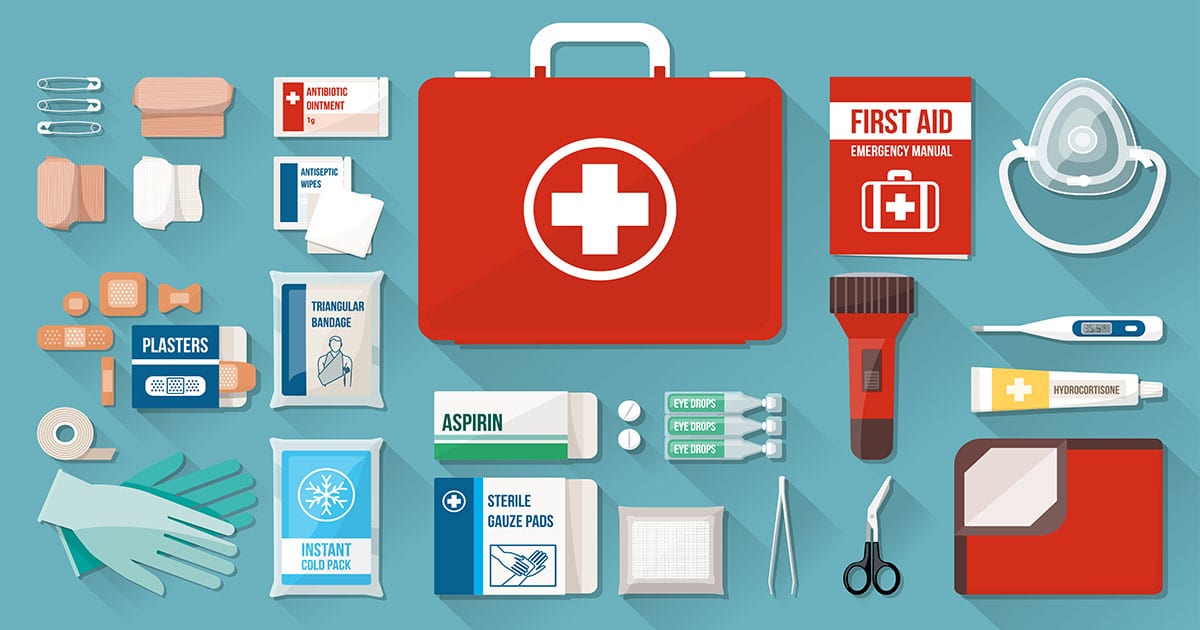
If you are able to provide the correct First Aid, you can help to:
- Save lives
- Prevent conditions from worsening
- Relieve pain and discomfort
- Promote recovery
- Protect the unconscious
Simple things you do can go a long way. An early response helps doctors maintain the chain of survival! If you manage to give someone CPR as soon as they need it, their chances of survival greatly increase. CPR helps prevent permanent brain damage. With CPR, you can prevent the victim from falling into a vegetative state.
I have seen a man suffer a heart attack while queuing for food at a hawker centre. Luckily, bystanders immediately started CPR and he was brought to the hospital in time. Last I heard, the man is still alive.
Based on experience, I could say that cases of DOA (dead on arrival) are more common in secluded areas as there is no one to provide first aid.
Memorise the RICE method
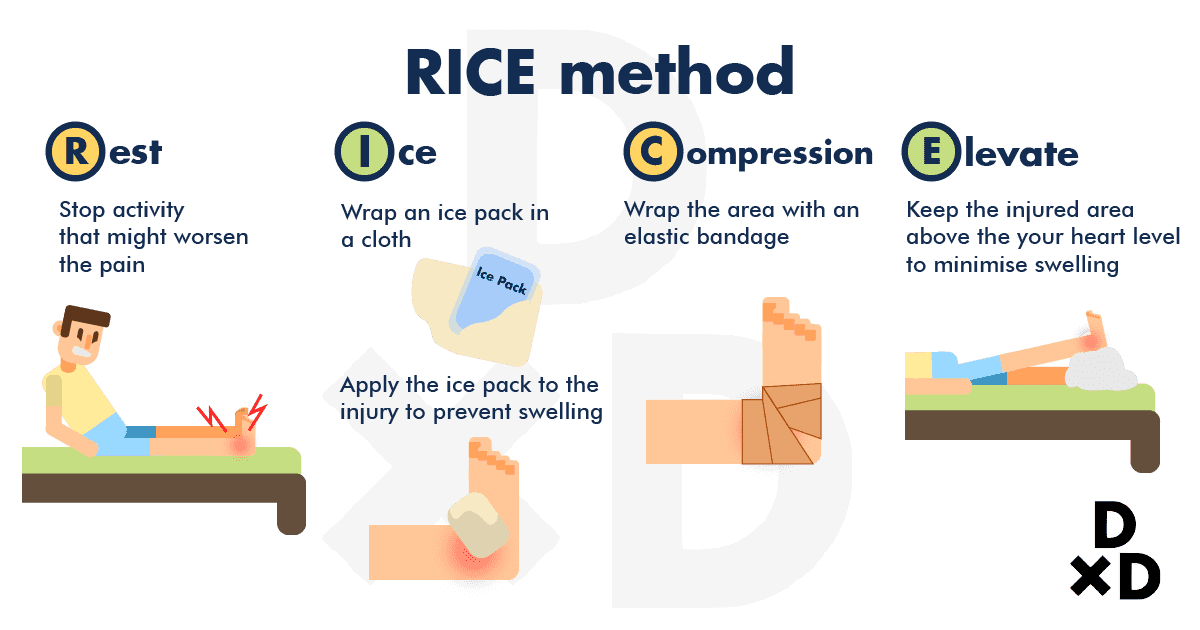
This is a method that can be used for almost all injuries. It can help relieve pain and swelling, as well as promote recovery. RICE stands for: [3]
Rest
Stop any activity that may cause or worsen the pain. It is crucial to protect the injured area from getting any more damage.
Ice
Ice can help reduce pain and swelling. If possible, apply ice or cold pack immediately after the injury to prevent swelling. It is important to note that you MUST NOT apply ice directly to the skin. Place a towel or cloth over the contact before applying the ice treatment.
Compression
Wrap the injured area with an elastic bandage to reduce swelling. Remember to not wrap it too tightly, otherwise, it may disrupt blood flow. Signs that the bandage is too tight include:
- Numbness
- Tingling
- Increased pain
- Coolness and swelling in the area below the bandage
- Skin colour turning blue
If you see any of those signs quickly loosen the bandage. Also, if you think you need to use an elastic bandage for longer than 48 hours, it is best to see a doctor. If the pain and swelling persist for more than 48 hours, it could be a sign of a bigger problem!
Elevation
Elevate the injured area whenever possible to minimise swelling. This means keeping the injured area above the chest level.
Common injuries
I have listed some common injuries below that you have probably seen or experienced. It will be good to keep in mind how to treat each of them!
Bleeding
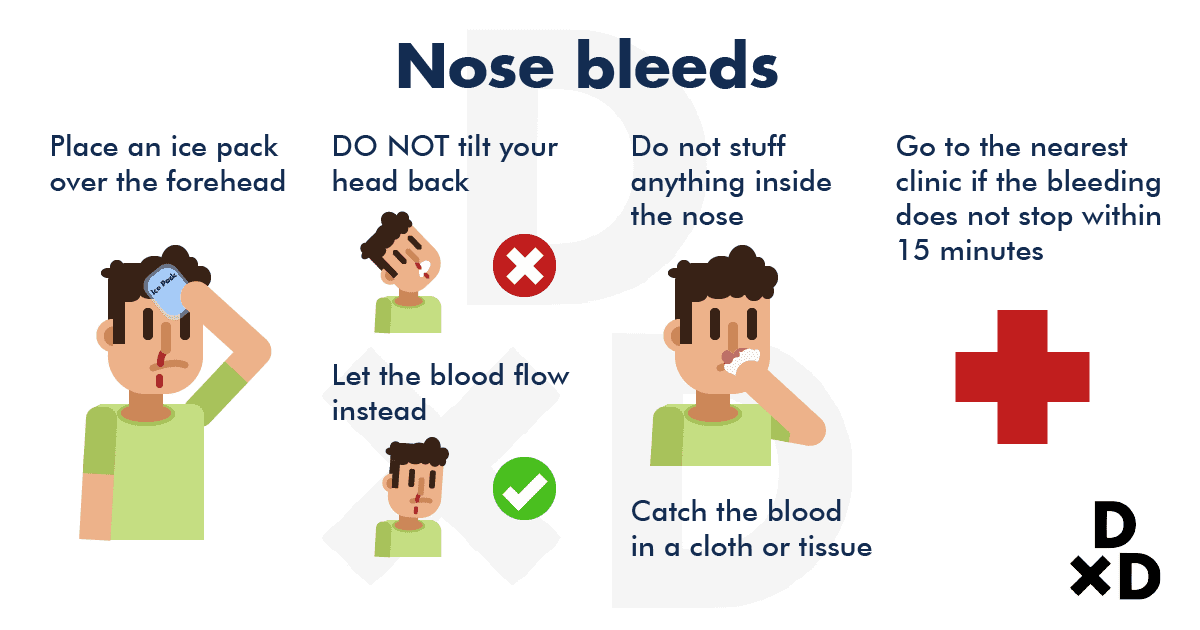
The simplest method is to apply pressure on the injury. In most cases, the blood flow out of a wound is slow and will eventually stop when you have applied pressure on it long enough. The pressure causes blood vessels to constrict and allows clots to form easier, thus stopping the flow.
The most common case of bleeding would probably be a nose bleed. For that, you can:
- Place ice packs over the forehead
- Let the blood flow! DO NOT tilt your head back and swallow back the blood. It is really bad for your stomach and could cause nausea and diarrhoea* Do not stuff anything inside the nose. Just let the blood slowly flow onto a paper towel or cloth
- If it does not stop in 15 minutes, go to the nearest clinic! It might be a sign of a way bigger problem and should be attended to immediately
In other cases of open wounds, if, by any chance, you see someone bleeding heavily, such as blood squirting everywhere, you should apply a tourniquet and call the ambulance immediately. When doing this, remember to note the time of application and let the medic know! This is because a tourniquet can cause damage to blood vessels and surrounding tissues if left on for too long.
Cuts & Bruises
Our body has an amazing immune system and can heal itself in the case of minor abrasion and scratches. You can simply rinse it with clean water to make sure it does not get infected. If you are unsure, or if you think it might be infected, it is best to visit a doctor.
If you have been bitten, it is also best to see a doctor immediately. Without proper treatment, a bite has a very high chance of infection!
Burn
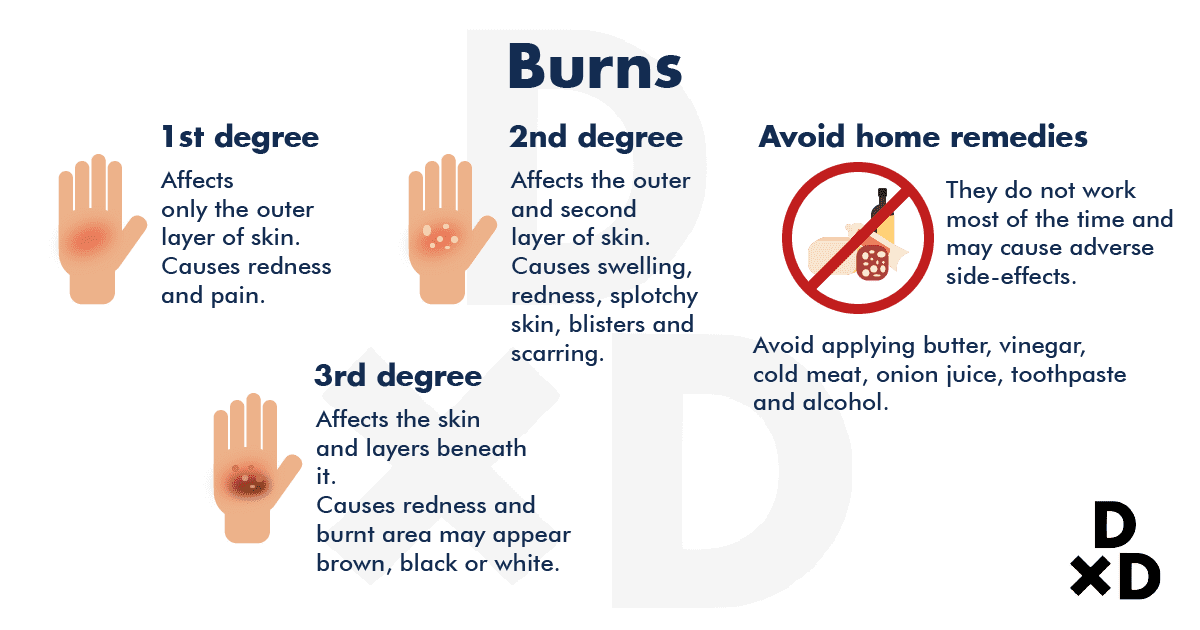
Symptoms of burn and its treatment depend on the degree of skin damage. It is classified into: [4]
1st degree:
Burns that affect only the outer layer of the skin (epidermis). It can cause redness and pain.
You should cool the skin immediately with running water. Make sure it is clean and then you can just leave it to heal.
2nd degree:
Burns that affect both the outer layer and the second layer of the skin (dermis). It can cause swelling and redness, as well as white or splotchy skin. In some cases, you may develop blisters and scarring.
You might also feel some pain that can be resolved by getting over-the-counter pain killers. That said, it is better to have a doctor check on the affected area to prevent infections and other complications.
3rd degree:
Burns that affect the skin and also layers beneath it. There will be redness and the burnt area may appear brown, black, or white. It may also look leathery. In some cases, 3rd degree burns may also affect the nerves and cause numbness.
For 3rd degree burns, you are highly urged to visit a doctor immediately, especially if the affected area covers a large part of the body. Severe burns can result in shock and even death.
Doctors may prescribe antibiotics to prevent or treat infections. Depending on the severity of the burn, you might also need to get a skin graft. This is a procedure where doctors transplant skin from another area to the burnt area.
In fact, it is important to AVOID using home remedies! Most of the time they do not work and may even cause adverse side-effects in the long run. To list, here are the things you should avoid:
- Butter
- Vinegar
- Cold meat
- Onion juice
- Toothpaste
- Alcohol
- Qin chao you
This is because we do not fully understand all the components in those items. They may have harmful chemicals that can cause more harm and increase the risk of infection.
Blisters
You can try to prick it with a sterile needle. After that, remember to clean it with water to prevent infection!
That said, you can also get a doctor to help you drain the blisters. This is especially if the blisters are big and painful.
Splinters

Remove the splinter with a sterile needle or tweezer, and then clean the area. When using a sterile needle, you should go along the direction of the splinter and pluck it out carefully. If you cannot remove it yourself, do find a doctor! If the splinter if left untreated, it could easily cause an infection.
Animal injuries
Bee sting
Remove the sting with a sterile tweezer. Remember to note for an allergic reaction! If you see any symptoms do visit a clinic as soon as possible.
Jellyfish sting
Rinse and soak the area with vinegar for 30 seconds. Carefully remove all the tentacles with a fine tweezer and then soak in warm water for 30 minutes.
Fractures
If you suspect a fracture, stabilise the area and reduce movement as much as possible. It is best to consult a doctor as soon as possible to prevent it from getting worse.
Ankle sprain
This actually happens more often than you think it does. A sprain happens when the ligaments of the ankle are stretched beyond their limits. As you might have guessed, this is most common during sports and other exercises.
For minor sprains, rest can easily resolve the pain after a few days. You should use the RICE method to help manage the pain and swelling! Physiotherapy might be required if the pain persists.
For severe strains where the ligaments are partially or completely torn, you might need an operative repair. If you are unsure, It is best to consult a doctor. Leaving this untreated could be bad and may affect your daily life!
Unconscious/Concussion

This might not be something you can resolve only through First Aid. The very first thing that you should do when you encounter an unconscious casualty is to call the ambulance.
Next, check the ABC of First Aid:
Airway
If the victim is facing down, gently roll him/her to their back. When moving the victim, be very careful if you suspect a neck or spine injury.
Use the head-tilt method to keep the casualty's mouth open and airway open. Gently press down on the victim’s forehead and lift the chin straight up with your other hand. Do not close the victim's mouth! Check visually for any solid or liquid foreign bodies in the airway that may cause a blockage; remove if there are any.
Breathing
Once the airway is clear, check for signs of breathing. Place your cheek near their mouth to look for the rising and falling of the chest, listen for breathing sounds and feel for airflow and moisture.
Circulation
After which, check for blood circulation by placing two fingers at the hollow areas along the left side of the throat to feel for a carotid pulse. Do not feel for radial pulse (reading pulse from the wrists) as it may not be accurate in unconscious patients. In the absence of pulse, commence cardiopulmonary resuscitation (CPR).
If the casualty is not breathing but shows signs of circulation, perform rescue breathing or mouth-to-mouth resuscitation. If the victim is not breathing and has no sign of circulation, do CPR. I’ll discuss more on this in the next section.
ABC is very important! By checking through this list, you can really help improve the victim’s chance of survival while waiting for the ambulance to come.
Basic Life Support
This refers to providing care for someone who has fallen unconscious, stopped breathing, has no heartbeat, or is suffering from heart fibrillation. When talking about Basic Life Support, this consists of two main things:
- CPR (Cardiopulmonary resuscitation)
- AED (Automated External Defibrillator)
CPR should be done immediately if the heart has stopped pumping
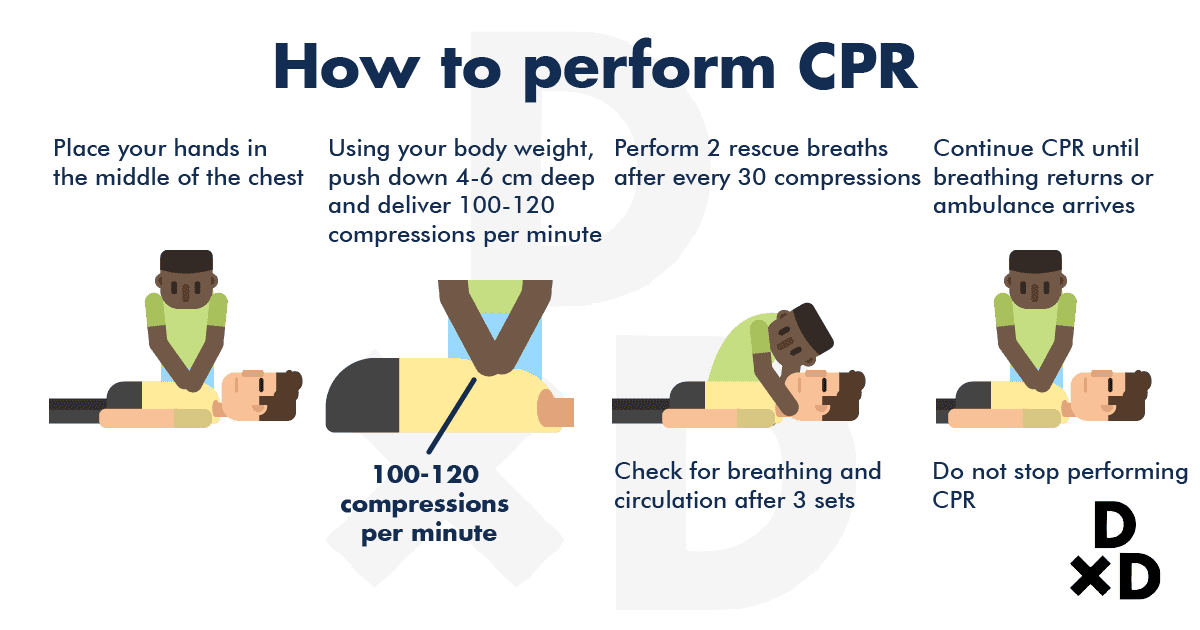
CPR ensures continued blood circulation and oxygen delivery when the heart is not functioning. These are the steps of CPR, explained simply: [5]
- Place your hands, one on top of the other, in the middle of the chest.
- Use your body weight to push down 4-6 cm deep, delivering at least 100-120 compressions per minute.
- Perform 2 rescue breaths after every 30 compressions. Check for breathing and circulation after 3 sets.
- If breathing and circulation do not return, continue CPR until breathing returns or until an ambulance arrives.
- Otherwise, at no point should CPR be stopped.
This is a simplified description of how CPR works. If you are interested, it is best to get proper training!
Another important note is to look for other people to support you whenever possible as CPR can be exhausting. The additional help, in addition to performing CPR in turns, can also help fetch the AED.
AED can correct heart fibrillation
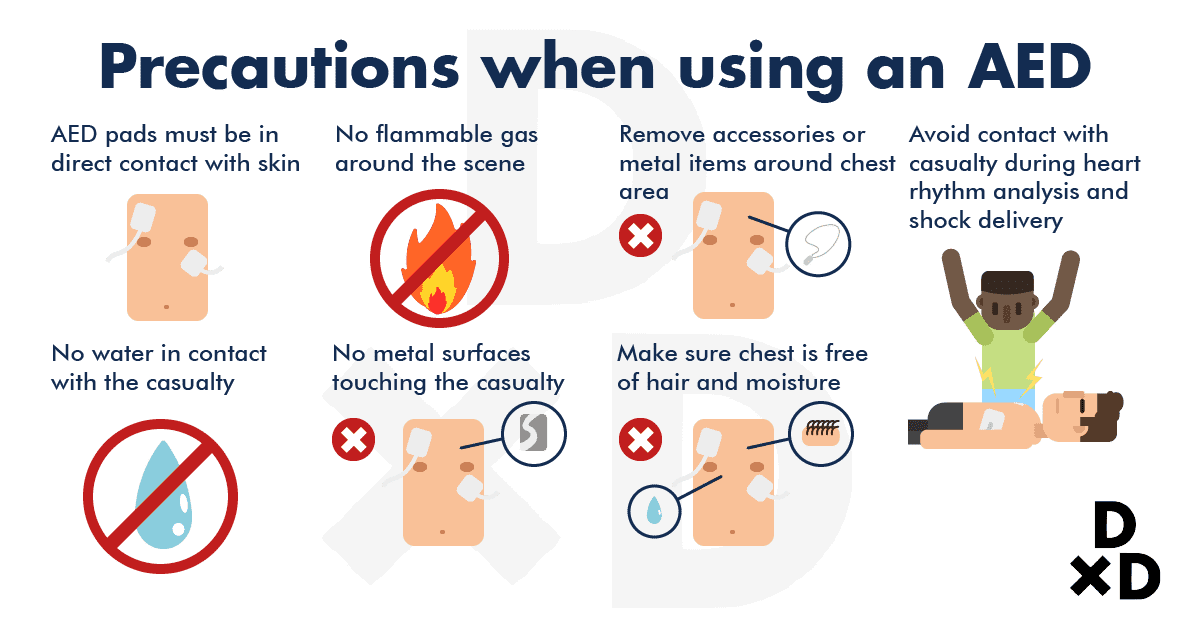
On top of CPR, an Automated External Defibrillator (AED) can increase one's chance of survival. Heart fibrillation refers to a quivering or irregular heartbeat due to the heart muscles receiving "faulty" electrical signals. By delivering a shock through the chest, the AED can correct the signal firing.
An AED is available in most public spaces today. In Singapore, you can find them in schools, universities, shopping centres, HDB blocks, and hawker centres. You can see the list of verified public access AED locations here. You can also download the SCDF myResponder app on your phone.
The usage is quite straightforward. Each AED will come with all the tools you need to perform an effective AED protocol. The AED machine will also give you verbal instructions via a recording, so pay attention to that and follow it. One person should continue with CPR while another person applies the AED pads.
Before using them, take note of these important precautions:
- The AED pads must be in direct contact with the skin
- Make sure there is NO water in contact with the casualty & NO flammable gas around the rescue scene
- Ensure there are NO metal surfaces in contact with the casualty
- Remove any accessories, adhesives or metal items around the chest area
- Wipe off any moisture and shave off chest hair
- When the AED is analysing heart rhythm or about to deliver a shock, no one should be touching the casualty
To use the machine, turn on AED and place the pads on bare skin as shown in the diagram. The AED pads often come with pictures on where you should place them.
Pay very close attention to the instructions from the AED machine. If it is analysing heart rhythm or is ready to shock, make sure NO ONE is touching the patient. This also means that the first aider should stop doing CPR in the meanwhile. The machine will prompt the first aider when it is appropriate to continue CPR. Continue until a medic arrives and remember to take turns if it is starting to exhaust you. It is also important to keep count of how many shocks were delivered and report it to the paramedics and doctors.
What do I do if I hear a crack?
This actually happens quite often when you do CPR. The sound is mostly caused by the cartilage or ribs cracking. But do not stop! Studies have shown that even when CPR is performed correctly, cracked ribs are found in one-third of the cases [6]. It may happen even if the CPR is done by a medic or doctor.
Singapore does not have an official Good Samaritan law, but it is generally understood that CPR can lead to cracked ribs. It is much better to have cracked ribs as they can be fixed. Not performing CPR on the other hand, could cost the victim his/her life!
Where do I learn first aid in Singapore?
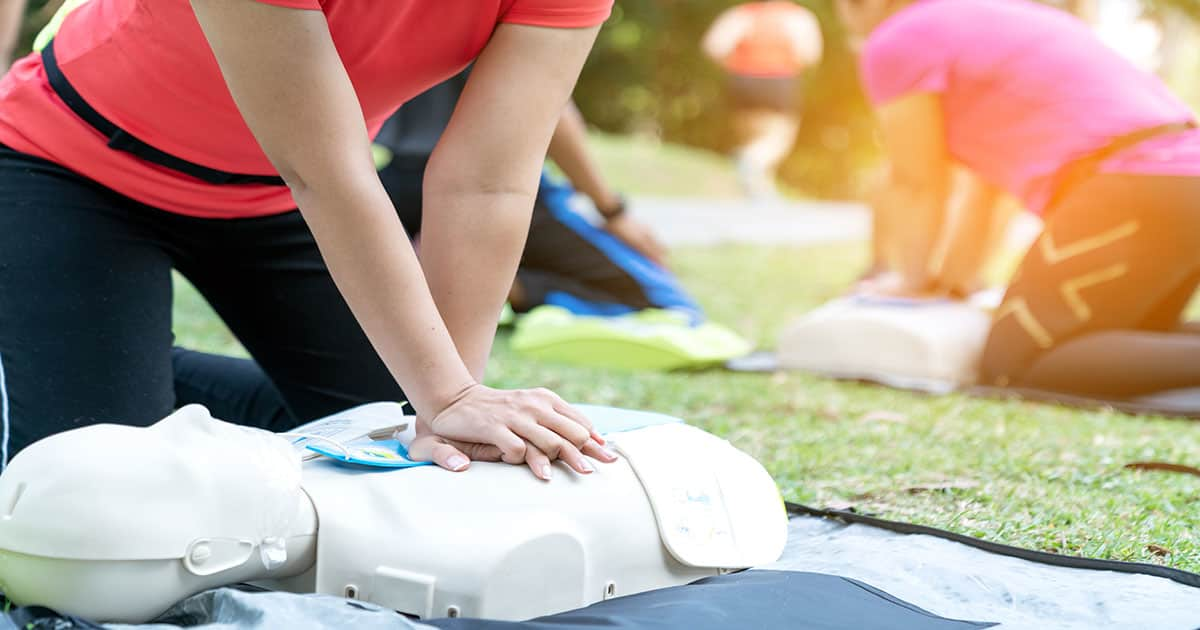
You can get official certification from:
- First aid societies
- Singapore Red cross
- Community clubs
- Anywhere else with an accreditation from the Singapore Resuscitation and First Aid Council (SRFAC)
There are different types of certificates available. I highly recommend getting at least the basic First Aid as well as the CPR and AED. Depending on the nature of your job, you might also need to take more advanced and occupation-specific courses. You can check online to find a class that is suitable for you.
Dr Paul Ang founded the Zenith Medical Clinic at Punggol West in 2014. With a keen interest to improve the delivery of General Practitioner (GP) services, Dr Ang aims to bring great, quality, affordable healthcare to the residents in Punggol, Singapore. Besides that, he enjoys cycling around Punggol and Sengkang with his family to maintain a healthy and well-balanced lifestyle in his free time.
Also, read more of Dr Paul Ang's QnA here.
Would you like to ask any related health questions?
You can Ask A Doctor right away, or request for treatment quotes from doctors.






